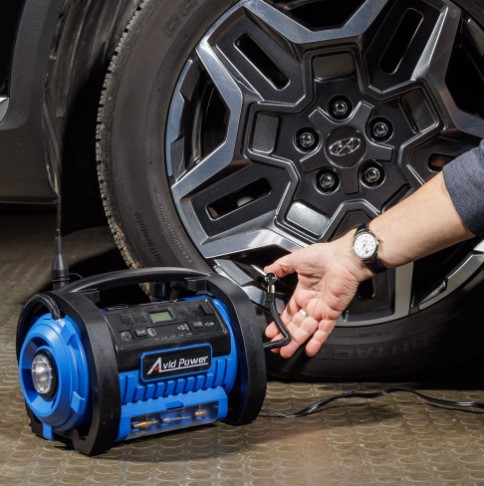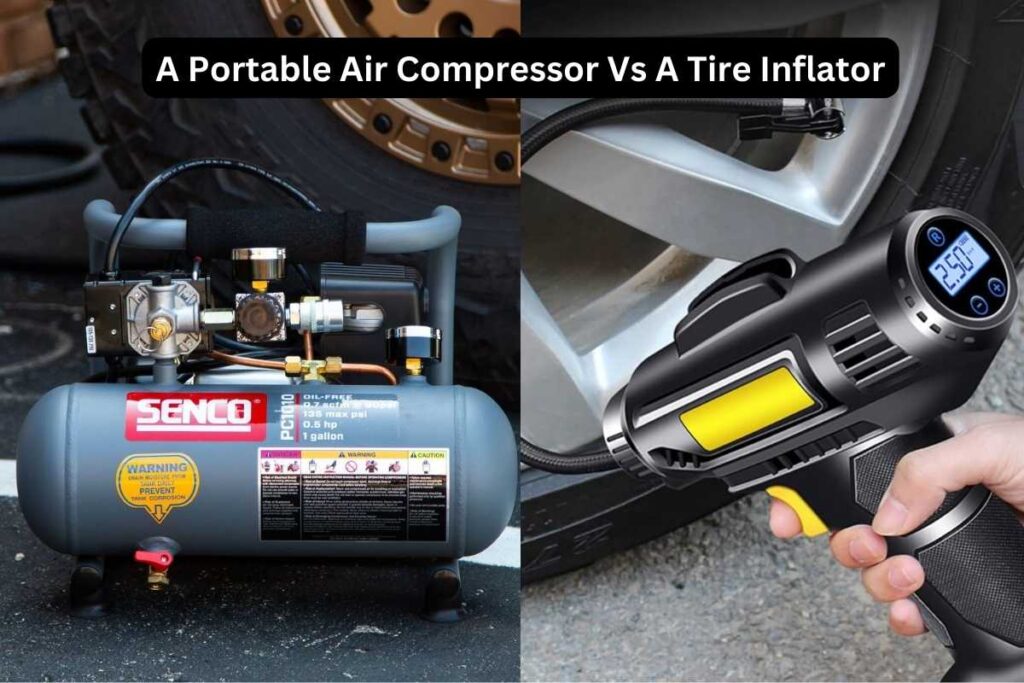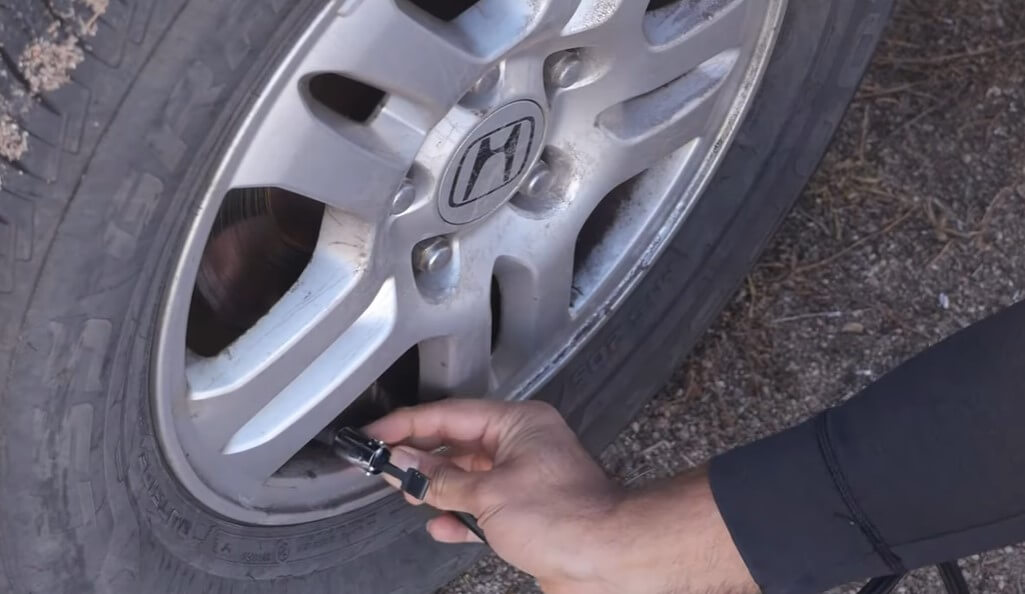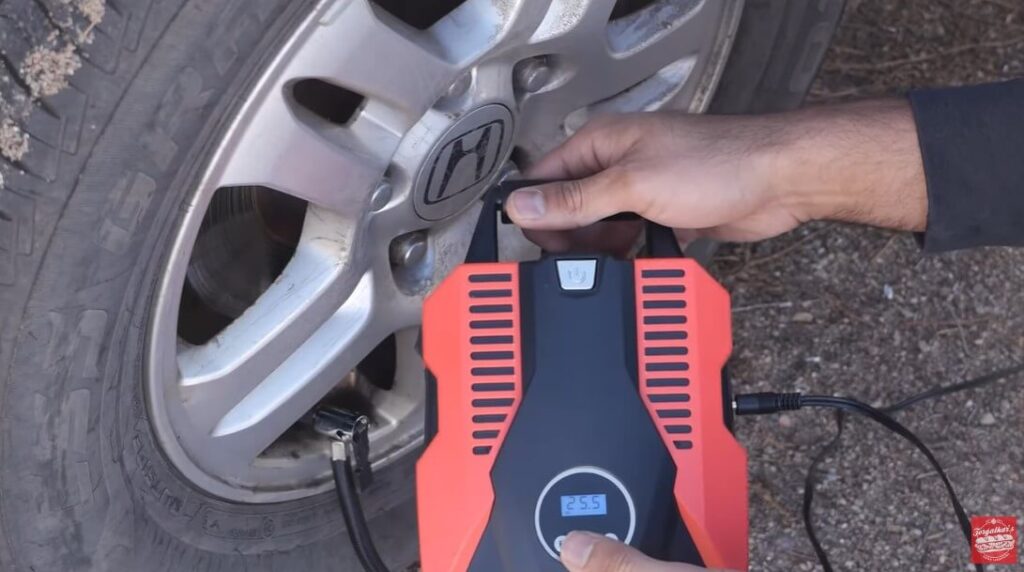Yes, portable air compressors can fill tires quickly. When it comes to maintaining vehicle tire pressure, a portable air compressor is a handy tool to have.
It can fill a tire efficiently and save you time and money by avoiding frequent trips to the gas station or garage. Portable air compressors are also useful for inflating other objects, such as footballs, bicycles, and air mattresses. With their compact size and portability, you can carry them around in your car trunk and use them wherever necessary.
However, it is important to choose the right size and capacity of the compressor to make sure it can handle the specific type of tires you have. In this article, we will look at the features of portable air compressors and how they can help you fill your tires quickly and easily.

What Is A Portable Air Compressor?
A portable air compressor is an amazing tool that compresses air and stores it in a tank. This stored air is then used through a hose connected to the tires that need to be filled. These compressors are of different sizes and shapes and are used for various purposes.

What Can You Do With A Portable Air Compressor?
Portable air compressors have a variety of uses across different industries and for personal applications. Here are some common uses:
- Inflating Tires: Portable air compressors are commonly used to inflate cars, bicycles, motorcycles, and other types of tires.
- Powering Pneumatic Tools: They can be used to power a wide range of pneumatic tools, such as nail guns, impact wrenches, and paint sprayers.
- Outdoor and Recreational Activities: Portable air compressors are handy for inflating sports equipment like soccer balls, basketballs, inflatable toys, and air mattresses during outdoor activities and camping trips.
- DIY Projects: DIY enthusiasts often use portable air compressors for tasks such as spray painting, airbrushing, and operating air-powered tools in workshops.
- Cleaning: Air compressors are used for cleaning applications, such as blowing dust and debris from surfaces or cleaning electronic equipment.
- HVAC Systems: Portable compressors are sometimes used for tasks related to heating, ventilation, and air conditioning (HVAC) systems.
- Emergency Repairs: In case of emergencies, portable air compressors can be used for quick fixes like reseating a bead on a tire or providing air to a stranded vehicle.
- Air Suspension Systems: Some vehicles with air suspension systems require an air compressor for proper functioning.
- Pressure Testing: They are used in various industries for pressure testing applications where a controlled air supply is needed.
- Medical Applications: In medical settings, portable air compressors can be used for certain respiratory devices and equipment.
It’s important to choose a portable air compressor with the appropriate specifications and features based on the intended use.
What Is The Difference Between An Air Compressor And A Tire Inflator?
An air compressor and a tire inflator, while sharing the common goal of providing compressed air, serve distinct purposes with differences in design, functionality, and intended applications.

Air Compressor:
- Functionality: An air compressor is a versatile device designed to compress and store air. It generates compressed air for a wide range of applications beyond tire inflation, such as powering pneumatic tools, spray guns, and various industrial machinery.
- Tank: Air compressors typically have a storage tank to store compressed air. This allows for a steady and immediate supply of air when needed.
- Power Source: They often come in various sizes and can be electric or gas-powered, providing flexibility for different settings and requirements.
- Pressure Regulation: Air compressors allow users to adjust and regulate the output pressure, making them suitable for diverse tasks that demand varying levels of compressed air.
Tire Inflator:
- Specialized Purpose: A tire inflator is specifically designed for the singular task of inflating vehicle tires. It focuses on portability and ease of use for this specific application.
- Compact Design: Tire inflators are typically compact, lightweight, and portable, making them convenient for on-the-go use or emergency situations.
- Direct Connection: Unlike air compressors with storage tanks, tire inflators often connect directly to the tire valve. They lack a storage tank and work by delivering air directly to the tire.
- Pressure Monitoring: Many tire inflators are equipped with pressure gauges or automatic shut-off features to ensure precise and safe tire inflation without overinflating.
In summary, while both devices involve compressing air, an air compressor is a multipurpose tool with a broader scope of applications, including industrial uses, whereas a tire inflator is a specialized, compact tool specifically tailored for inflating vehicle tires efficiently.
How Do Portable Air Compressors Work?
Portable air compressors work by drawing air into the unit’s tank and compressing it to a specific pressure. The compressed air is then stored in the tank. This compressed air can be used in short bursts or for more extended use, depending on your needs.
They include an attached pressure gauge that measures the air pressure that is being output.
What Are The Different Types Of Tires?
There are numerous types of tires available on the market, and each type is designed for a different purpose. Understanding the different types can help you make informed decisions on what types of tires to get.
Below are some well-known tire types:
- Summer tires: These tires are designed for hot weather. They are made of soft rubber, and the shallower tread grips are ideal for dry and wet conditions. However, their performance diminishes in cold temperatures and snowy conditions.
- Winter tires: These tires are designed for colder weather and are made of softer rubber and deeper tread depths with sipes and small slits that enhance traction and grip on ice-covered roads or in slippery conditions. Winter tires provide improved handling and braking performance in cold weather.
- All-season tires: These tires are a mix between summer and winter tires. They offer a balance of traction and handling in both warm and cold weather conditions. Hence, they are great for use all year round, but they are not as efficient as either of the two types during extreme weather conditions.
- Performance Tires: Performance tires are engineered for high-performance vehicles and enthusiasts. They prioritize handling, responsiveness, and cornering abilities over comfort and tread life. Performance tires feature wider tread widths, lower sidewalls, and specialized tread patterns.
- All-Terrain Tires: All-terrain tires are designed for light trucks, SUVs, and off-road vehicles. They combine aggressive tread patterns with durable construction, providing traction on various terrains, including gravel, dirt, and rocks. While they offer off-road capability, they may not be ideal for smooth pavements.
- Mud-Terrain Tires: Mud-terrain tires are specifically designed for extreme off-road driving. They feature aggressive tread patterns with large gaps between tread blocks, providing exceptional traction in deep mud, loose rocks, and uneven terrain. However, their aggressive tread can increase road noise and reduce fuel efficiency.
- Highway Tires: Highway tires are designed for trucks and vans used primarily for highway driving. They prioritize fuel efficiency, a smooth ride, and long tread life over off-road capabilities. Highway tires feature shallower tread depths and smoother tread patterns.
What Tire Pressure Is Appropriate For Each Type Of Tire?
When it comes to tire pressure, it’s crucial to adhere to the manufacturer’s recommendations. The recommended tire pressure can vary based on the type of tire and the vehicle. However, as a general guideline:
Passenger Car Tires: For standard, everyday cars, the recommended tire pressure often falls in the range of 32 to 35 PSI (pounds per square inch).
SUV and Light Truck Tires: These vehicles might require slightly higher pressure, typically ranging from 35 to 40 PSI.
Performance Tires: High-performance or sports car tires might have different recommendations, often on the higher end of the scale, around 40 to 45 PSI.
Trailers: The recommended tire pressure for trailers varies depending on the size and weight of the trailer. It is important to consult the trailer’s manual for the specific tire pressure recommendations.
Bicycle tires: The recommended tire pressure for bicycle tires varies depending on the type of tire and the weight of the rider. The recommended pressure is usually found on the side of the tire.
Motorcycle tires: The recommended tire pressure for motorcycle tires varies depending on the type of motorcycle and the type of tire. The recommended tire pressure for motor cycles is range of 28 to 40 PSI.
Let’s find a chart for tire type vs recommended air pressure (PSI):
| Tire Type | Recommended Air Pressure (PSI) |
|---|---|
| Passenger car tires | 32-35 PSI |
| Light truck tires | 35-40 PSI |
| Heavy truck tires | 40-80 PSI |
| Motorcycle tires | 25-40 PSI |
| Trailer tires | 35-65 PSI |
| RV tires | 65-80 PSI |
Always refer to your vehicle’s manual or the tire placard located on the driver’s side door jamb for precise information. Keeping your tires properly inflated is crucial for safety, fuel efficiency, and overall tire longevity.
Overall, portable air compressors are a must-have for any driver who needs to keep their tires safe and roadworthy.
Can I Use A Portable Air Compressor To Inflate Different Tires?
Absolutely, they sure can! Portable air compressors are versatile and designed to inflate various types of tires. Whether you’re dealing with car tires, bike tires, inflatable sports equipment, or even some smaller vehicle tires, a portable air compressor can handle the job.
These handy devices usually come with different nozzle attachments, making them compatible with a range of tire valve types. Just ensure that the compressor’s pressure range aligns with the recommended pressure for the specific type of tire you’re inflating.
To understand whether portable air compressors are compatible with inflating tires or not, you can check the following points:
- PSI rating: Check your vehicle’s manual or the sidewall of your tire to determine the recommended PSI level. Ensure that the portable air compressor can achieve that level.
- Valve connector: Make sure the portable air compressor’s valve connector is compatible with your tire’s valve stem.
- Duty cycle: The duty cycle is the amount of time the air compressor can run before it needs to cool down. Ensure the air compressor’s duty cycle allows you to fill all tires without overheating.
So, whether you’re on the road with your car, bike, or any other inflatable gear, a portable air compressor can be a reliable companion for keeping your tires properly inflated.
What Are The Pros And Cons Of Using A Portable Air Compressor To Fill Tires?
Using a portable air compressor to fill your tires has its advantages and disadvantages. Here are some key points to keep in mind:
Advantages of Using Portable Air Compressor:
- Portability: As the name suggests, portability is a major advantage. Portable air compressors are compact and lightweight, making them easy to carry and store. This is especially handy for on-the-go situations or emergencies.
- Versatility: Portable air compressors come with various nozzle attachments, making them versatile for inflating different types of tires, as well as sports equipment, air mattresses, and more.
- Convenience: Having a portable air compressor provides convenience, allowing you to inflate your tires at your preferred location without the need to visit a gas station or service center.
- Time Savings: With a portable compressor, you can quickly and efficiently inflate your tires, saving you time and effort compared to manual methods like using a hand pump.
- Affordability: Portable air compressors are more budget-friendly compared to larger, stationary options and offer good value for their price.
Drawbacks of Using Portable Compressor:
- Power Source: Portable air compressors typically rely on either a car’s battery or a separate power source. This means they may not be suitable for situations where a power source is unavailable.
- Noise Level: Some portable compressors can be noisy during operation, which may be a concern, especially in quiet or residential areas.
- Duty Cycle: Portable compressors often have a duty cycle, indicating the amount of time they can run continuously before needing a cool down period. This might be a limitation when inflating multiple tires consecutively.
- Pressure Accuracy: While portable compressors can get the job done, their pressure gauges might not be as accurate as those in more specialized and larger units.
Time-consuming: Filling your tires with a portable air compressor takes longer than using an air compressor at a gas station. It can also require multiple attachments to complete the job.
How To Fill Tires With A Portable Air Compressor?
When it comes to filling tires with a portable air compressor, it’s crucial to do it safely and efficiently. Here are the steps to follow:
1. Prepare Your Tools:
Make sure you have the necessary tools, including the tire inflator and the appropriate nozzle attachment for your type of tire valve.
2. Check the Air Compressor:
Ensure that your air compressor is in good working condition and has sufficient pressure for your tire inflation needs.
3. Turn Off the Air Compressor:
Before attaching the tire inflator, make sure the air compressor is turned off to avoid any accidental inflation.
4. Locate the Air Hose Outlet:
Identify the air hose outlet on the air compressor. It’s usually a threaded connector where you’ll attach the tire inflator.
5. Prepare the Tire Inflator:
If your tire inflator has a built-in pressure gauge, set it to the desired PSI for your tire. If not, be prepared to monitor the pressure using a separate gauge.
6. Attach the Nozzle:
Take the appropriate nozzle attachment for your tire valve and screw it onto the air hose outlet. Ensure it’s securely fastened to prevent air leakage.
7. Connect the Tire Inflator:
Attach the other end of the nozzle attachment to the valve on your tire. Press it firmly to ensure a tight seal.

8. Turn On the Air Compressor:
Once everything is securely connected, turn on the air compressor. Monitor the pressure on the tire inflator gauge if it has one, or use a separate pressure gauge.
9. Inflate the Tire:
Allow the air compressor to inflate the tire to the desired PSI. If your tire inflator has an automatic shutoff feature, it will stop once the set pressure is reached.
10. Disconnect and Check:
Once the tire is properly inflated, turn off the air compressor, disconnect the tire inflator from the valve, and check the tire pressure with a separate gauge to ensure accuracy.
Remember to follow the specific instructions provided with your tire inflator and air compressor, as designs may vary.
What PSI Should I Set My Air Compressor To Fill Tires?
The appropriate PSI setting for your air compressor to fill tires depends on the recommended tire pressure for your vehicle. Most passenger car tires should be inflated to between 32 and 35 PSI (pounds per square inch).
However, it is important to check the specific tire pressure recommendation for your vehicle, as this can vary depending on the vehicle’s weight, size, and load. You can find the recommended tire pressure for your vehicle on a sticker on the driver’s side door jamb or in your owner’s manual.
It is generally recommended to set your air compressor to a PSI that is about 10 PSI higher than the recommended tire pressure for your vehicle. This will give you enough pressure to quickly inflate your tires, but it will not be so high that it could damage your tires.
For example, if the recommended tire pressure for your vehicle is 32 PSI, you would set your air compressor to 42 PSI.

Once you have set your air compressor to the appropriate PSI, you can connect the air hose to the tire valve and begin inflating the tire. Be sure to monitor the tire pressure closely as you inflate it, and stop inflating once the tire reaches the recommended pressure.
How To Inflate Car Tires At Home?
Inflating car tires at home is a simple task. Here’s a step-by-step guide to help you through the process:
1. Gather Your Tools:
You’ll need an air compressor, a tire inflator with the appropriate nozzle for your valve, and a tire pressure gauge.
2. Check Tire Pressure:
Refer to your vehicle’s manual or the tire placard on the driver’s side door jamb for the recommended PSI (pounds per square inch) for your tires.
3. Prepare the Air Compressor:
Ensure your air compressor is in good working condition and has sufficient pressure. If necessary, connect it to a power source.
4. Turn Off the Car:
For safety reasons, turn off your car engine before inflating the tires.
5. Locate Valve Stem:
Identify the valve stem on your tire. It’s a small, cylindrical protrusion on the wheel.
6. Remove Valve Cap:
Unscrew the valve cap from the valve stem and set it aside.
7. Attach Nozzle to Valve:
Take the appropriate nozzle attachment for your tire inflator and securely attach it to the valve stem. Ensure a tight seal to prevent air leakage.
8. Set Tire Inflator PSI:
If your tire inflator has a pressure gauge, set it to the recommended PSI for your tires. If not, use a separate pressure gauge to monitor the inflation.
9. Turn On the Air Compressor:
Switch on the air compressor and let it inflate the tire. Keep an eye on the pressure gauge to ensure you reach the recommended PSI.
10. Monitor and Adjust:
Periodically check the pressure during inflation using the tire pressure gauge. Stop when you reach the recommended PSI.
11. Disconnect and Replace Valve Cap:
Once the tire is properly inflated, turn off the air compressor, disconnect the nozzle from the valve stem, and promptly replace the valve cap.
12. Repeat for Other Tires:
Repeat the process for the remaining tires, checking and adjusting the pressure as needed.
13. Final Check:
After inflating all tires, do a final check using the tire pressure gauge to ensure they are at the correct PSI.
That’s it! You’ve successfully inflated your car tires at home. If you have any questions or encounter any issues during the process, feel free to ask for assistance.
What Are The Possible Risks When Using A Portable Air Compressor To Fill Tires?
While filling tires with a portable air compressor can be a straightforward process, there are some hazards to be aware of. Here’s what you need to keep in mind:
- Over inflation: Overinflated tires can be dangerous and may cause a blowout. Make sure to check the tire pressure periodically using a tire pressure gauge.
- Heat buildup: Filling tires with a portable air compressor can cause heat buildup, especially if you’re inflating multiple tires in quick succession. Allow the compressor to cool down between inflations.
- Electrical hazards: Portable air compressors run on electricity, so make sure to use them safely. Keep the compressor dry and away from water, and never touch it with wet hands. Follow the manufacturer’s instructions carefully.
When using a portable air compressor to fill tires, what are some troubleshooting tips to try?
If you experience issues with filling tires using a portable air compressor, here are some troubleshooting tips:
- If the air compressor won’t turn on, check if it’s plugged in and make sure the circuit breaker hasn’t tripped.
- If the air compressor is running but not inflating the tire, check for leaks in the air hose or the connections between the hose and the compressor or chuck.
- If the compressor is too weak to inflate the tire to the desired pressure, it may not be powerful enough for your needs. Consider purchasing a more powerful compressor if you need to inflate larger tires or other items.
Filling tires with a portable air compressor is a handy skill to have. By following the steps outlined above and being aware of potential hazards, you can do it safely and efficiently.
Remember to always use the compressor according to the manufacturer’s instructions and to check the tire pressure regularly.
FAQs: Can A Portable Air Compressor Fill A Tires?
Can A Portable Air Compressor Fill A Tire?
Yes, a portable air compressor can fill a tire, but the time taken may vary.
How Long Does It Take To Fill A Tire With A Portable Air Compressor?
It depends on the size of the tire and the required pressure. Usually, it takes about 10-15 minutes.
What Type Of Tires Can A Portable Air Compressor Fill?
A portable air compressor can fill all types of tires, including car, truck, and bike tires.
Is It Safe To Use A Portable Air Compressor To Fill A Tire?
Yes, it is safe to use a portable air compressor to fill a tire, but make sure to follow the safety instructions.
Can A Portable Air Compressor Overinflate A Tire?
Yes, it is possible to overinflate a tire with a portable air compressor. Be cautious, and keep an eye on the pressure gauge.
Can I Use a Portable Air Compressor to Inflate Other Objects?
Yes, a portable air compressor can inflate other objects, including sports balls, pool toys, and air mattresses.
How Do I Select the Right Portable Air Compressor for Inflating Tires?
Consider the CFM rating, maximum pressure, and size of the tank while selecting a portable air compressor for inflating tires.
Conclusion
To sum it up, portable air compressors are effective tools for inflating car tires. However, it is vital to understand that not every model is suitable for this task. Before purchasing a portable air compressor, make sure it has enough power to fill the tires of your vehicles.
Additionally, check its specifications to ensure that it comes with the right accessories, such as a pressure gauge and hose. Regular maintenance of your portable air compressor is also essential to maximize its lifespan and performance. If taken care of properly, a portable air compressor can offer a quick and convenient solution for inflating tires on the go.
So, invest in a good-quality portable air compressor and enjoy a hassle-free drive without worrying about flat tires or low pressure.
Recent Posts
Woodworking in 2025 is all about efficiency, precision, and smart technology. Whether you're a beginner or a seasoned craftsman, having the right tools can make all the difference. Here are the top 7...
Ever tried drilling into a piece of wood only to end up with a splintered mess or a wobbly hole? Yeah, it's more common than you think. Wood might seem like an easy material to work with, but...

